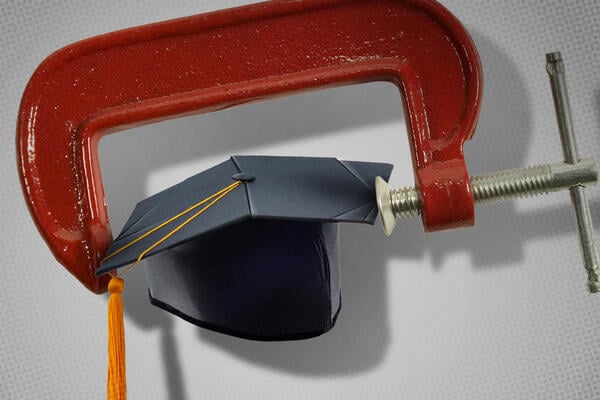
Loan Caps Could Force Students Into Private Market
At least a quarter of students across a broad range of graduate and professional programs could need private loans, which tend to come with higher interest rates, in order to pay for their education once new caps on federal loans take effect next summer, multiple studies show. For some, the loans could become so costly as to make earning a master’s or doctoral degree unattainable.
Currently, this group can borrow federal loans up to the total cost of attendance thanks to a program known as Grad PLUS. But starting July 1, students will max out at either $20,500 or $50,000 per year depending on whether they enroll in a graduate or professional program, respectively. And those in graduate programs will only be able to take out $100,000 over all, while students in professional programs will be limited to $200,000. Congress made the changes as part of the One Big Beautiful Bill Act, which passed earlier this summer.
The caps mean that the median borrower in four of the nine largest professional programs likely will need to find other financing to pay tuition bills, according to a recent analysis from the Postsecondary Education and Economics Research Center at American University. Borrowers in the 75th percentile exceed the cap in six of the nine fields.
And it’s not just the most costly doctoral programs such as medicine and dentistry in which students will face such a challenge, PEER notes. Out of the 30 master’s degree programs with the highest loan volume, 50 percent of students exceed the cap in nearly half of them.
Many of these students could struggle to find a private lender to make up the difference, potentially forcing them to drop out or not enroll in the first place, policy experts at PEER and other research groups say. And even if a student finds a lender, taking out a private loan could lead to steep, sometimes predatory, interest rates that take decades to pay off. (Research shows that low-income individuals particularly struggle to secure private financing because of a range of factors such as low credit scores, a lack of assets or an inconsistent flow of income.)
Before this new law, “students could have just filled out their FAFSA, applied for loans through the Department of Education and been able to borrow up to the full cost of attendance of their program,” said Jordan Matsudaira, director of the PEER Center and a former deputy under secretary at the Department of Education.
But now, for upward of a quarter of graduate students, it likely won’t be that simple.
“I think that will come as a surprise to a lot of people,” he said.
Can Private Lenders Fill the Gap?
Other researchers at Urban Institute and Jobs for the Future have also crunched the numbers on the loan caps and reached similar findings.
Jobs for the Future estimated in a report released last month that if this loan cap had been in place for the 2019–20 graduating class, roughly 38 percent of graduate borrowers would have needed to take out more loans beyond the cap. And thanks to the limit, the federal government would have issued $9.7 billion less in loans—a decrease of about 28 percent, according to the report.
Urban also used data from 2019–20 but broke it down by program, finding that dentistry would have the largest share of students exceeding the cap. About 56 percent would have exceeded the annual limit, and 58 percent blew through the aggregate cap. Other programs with a high share of students that could be pushed into the private market include medicine, at 41 percent, a master’s in public health, at 29 percent, and a master’s in fine arts, at 26 percent.
Policy experts on both sides of the political aisle tend to agree that the student debt crisis needs to be addressed. But unlike conservative lawmakers and analysts who believe these caps are necessary in order to lessen student debt and encourage colleges to lower costs, some researchers worry the limits are too aggressive and don’t account for nuances like a program’s return on investment.
“The kind of pain involved here is a little bit bigger than it needed to be to rein in the most egregious abuses in the system,” Matsudaira said. “The better approach over all would have been to adopt an approach where different fields of study had different limits that were scaled with borrowers’ ability to repay.”
Some questions about how the loan limits will work and which programs they’ll apply to will be answered later this month when the Education Department starts to work through the rule-making process to carry out the law’s provisions. Representatives from nursing, aviation and social work have already started to speak out about why their programs should be considered professional degrees and therefore be eligible for the higher cap.
“In today’s economy, the majority of graduate education is practical and workforce-aligned, preparing students for jobs in health care, education, counseling, technology and much more,” Stephanie Giesecke, a representative of the National Association of Independent Colleges and Universities, said at a public hearing in August. “The definition that is too narrow risks excluding programs that are vitally important to communities and employers nationwide.”
Like Matsudaira, Ethan Pollack, a senior director of policy at JFF, said that while he sympathizes with the Republican diagnosis that debt is too high, he probably would have gone about addressing it a different way. But rather than suggesting changes to the cap itself, JFF’s report looked at the financial impact on borrowers and suggested ways that institutions, the government and private lenders can adjust in response.
One key recommendation was the use of outcomes-based financing for private loans, which would base payments in part on borrowers’ earnings after graduating. Pollack said that this approach could help students who lack strong credit histories or cosigners still pursue well-paying degrees like a juris doctorate.
But current regulations, like requiring a bank to disclose a flat annual percentage rate, or APR, when offering a loan, make it difficult for some private vendors to explore new models like outcomes-based financing, he explained. If the government were to build on the recent legislation by amending current regulations and introducing new guardrails for private lenders, Pollack added, the OBF model could make nonfederal loans more affordable for borrowers of all backgrounds.
“The federal government, in some sense, is stepping on the gas and the brake at the same time,” he said. “They’re saying that they want the private market to be stepping up, but at the same time, the federal government is one of the obstacles to the private market being able to step up in the way that we would all like them to, which is to be offering financing with much more student-friendly terms.”
Matsudaira, on the other hand, was more skeptical.
“The big question is whether the private sector is really going to be able to come in and fill a hole that big,” he said. “And even if they do, how long does it take for them to spin up to be able to do those kinds of things?”
Source link



